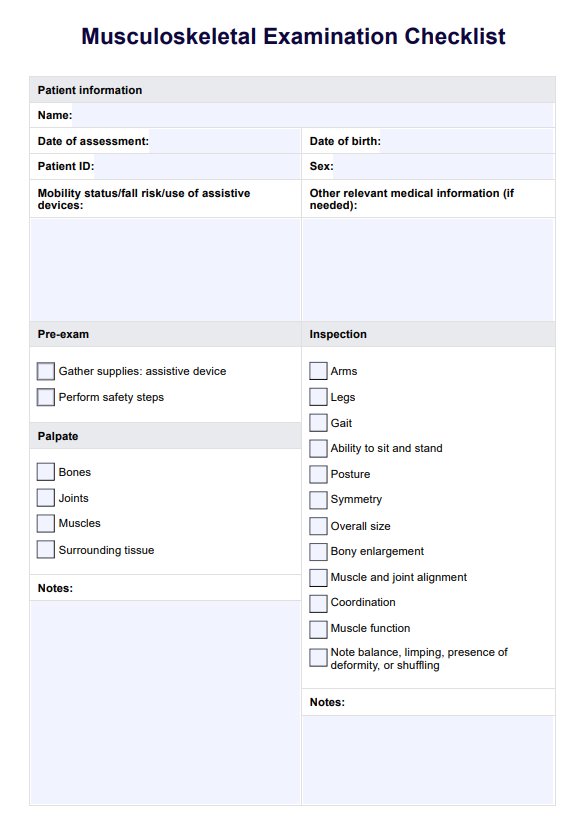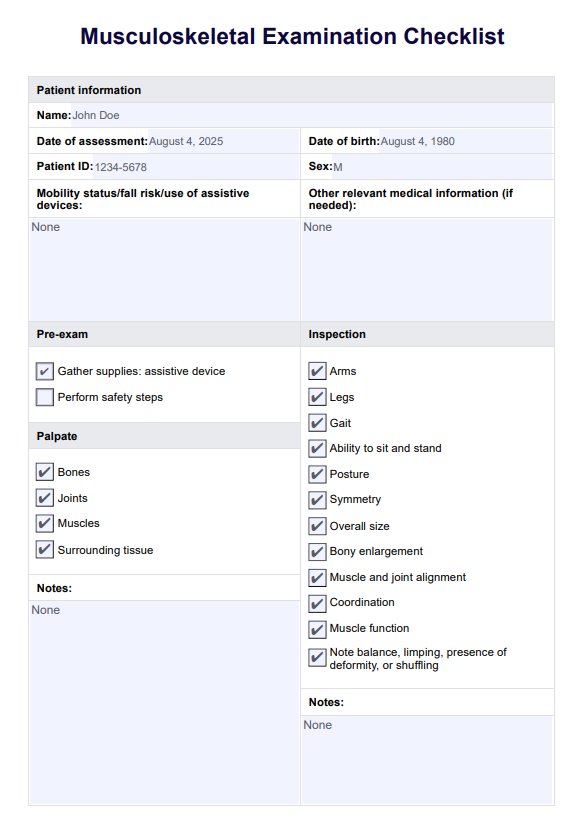Musculoskeletal Examination Checklist
Explore a comprehensive guide on musculoskeletal system examination, conditions, treatments, and FAQs with a free checklist PDF download.


What is the musculoskeletal system?
The musculoskeletal system is an organ system that enables humans and other animals to move using the muscular and skeletal systems. It provides form, support, stability, and movement to the upper and lower extremities of the body. This system comprises bones, muscles, cartilage, tendons, ligaments, joints, and other connective tissue that supports and binds tissues and organs together.
Key components and functions include:
- Bones: Provide a rigid framework for the body and protect vital organs. Bones also serve as stores of minerals such as calcium and phosphorus.
- Muscles: Facilitated by the nervous system, muscles contract to initiate movement. They are responsible for locomotion and play a critical role in bodily functions such as circulation and digestion.
- Joints: The areas where two or more bones meet. Joints allow for movement and flexibility. Different types of joints offer varying degrees of movement, from the highly mobile shoulder joints to the somewhat immobile joints of the skull.
- Tendons: Connect muscles to bones, transmitting the force from muscle contraction to bones to facilitate movement.
- Ligaments: Connect bones to other bones, providing joint stability and guiding joint movement.
- Cartilage: A tough, flexible tissue that covers the ends of bones at joints; it helps reduce friction and acts as a shock absorber.
The musculoskeletal system is critical for the range of motion, supporting and protecting the body's vital organs, producing blood cells (hematopoiesis in the bone marrow), and storing essential minerals. It's also subject to various disorders, from acute pain or muscle spasms to chronic conditions like arthritis and osteoporosis.
Musculoskeletal Examination Checklist Template
Musculoskeletal Examination Checklist Example
What are examples of musculoskeletal conditions?
Musculoskeletal conditions encompass various disorders that affect the musculoskeletal system, including the bones, muscles, joints, tendons, ligaments, and nerves. Some common examples include:
- Osteoarthritis: A degenerative joint disease characterized by the breakdown of cartilage in joints, leading to pain, stiffness, and reduced mobility.
- Rheumatoid arthritis: An autoimmune disorder where the body's immune system attacks the lining of the joints, causing inflammation, pain, and joint damage.
- Osteoporosis: A condition characterized by weakened bones, making them more fragile and prone to fractures.
- Back pain: It can be caused by various issues, including muscle or tendon strain, herniated discs, or degenerative disc disease.
- Tendinitis: Inflammation or irritation of a tendon, often caused by repetitive stress or sudden injury.
- Carpal tunnel syndrome: A condition caused by pressure on the median nerve in the wrist, leading to numbness, tingling, and weakness in the hand.
- Fibromyalgia: A disorder characterized by widespread musculoskeletal pain accompanied by fatigue, sleep, memory, and mood issues.
- Scoliosis: A condition in which the spine curves to the side, which can lead to discomfort and reduced mobility.
What causes such conditions to develop?
Many factors can cause musculoskeletal conditions, and it's easy to tell with patient cues. These often involve a combination of genetic, environmental, and lifestyle influences:
- Genetic predisposition can be significant, especially in rheumatoid arthritis and osteoporosis.
- Aging increases the risk of musculoskeletal conditions, such as osteoarthritis and osteoporosis, due to joint wear and tear and decreased bone density.
- Injury or overuse can lead to conditions like tendinitis, carpal tunnel syndrome, and acute back pain.
- Autoimmune disorders result in the body attacking its tissues, which can lead to conditions like rheumatoid arthritis.
- Lifestyle factors, including poor posture, inadequate physical activity, obesity, and repetitive stress from certain occupations or sports, can predispose individuals to various musculoskeletal problems.
- Nutritional deficiencies, particularly calcium and vitamin D, can affect bone health and lead to osteoporosis.
What problems can musculoskeletal conditions lead to if left untreated?
If left untreated, musculoskeletal conditions can lead to a range of problems, significantly with mobility status impacting quality of life:
- Chronic pain and discomfort can become a constant issue, affecting daily activities and mental health.
- Reduced mobility and flexibility may result from joint damage, muscle weakness, or skeletal deformities, making it difficult to perform everyday tasks.
- Increased risk of falls and fractures, particularly in conditions like osteoporosis, where bones become fragile.
- Progression of the disease can lead to more severe symptoms and complications. For example, untreated rheumatoid arthritis can result in significant joint damage and deformity.
- Decreased independence due to mobility and functionality limitations.
- Mental health issues, such as depression and anxiety, can develop or worsen due to chronic pain and disability.
Early diagnosis and appropriate management of musculoskeletal conditions are crucial to minimize these complications and maintain quality of life.
What does a musculoskeletal examination entail?
A musculoskeletal assessment is a comprehensive examination performed by healthcare professionals to evaluate the condition of a patient's musculoskeletal system, including upper and lower extremities. The examination aims to identify any abnormalities, limitations, or dysfunctions that may indicate underlying conditions or injuries.
It typically involves a series of physical examination techniques performed, observations, noting down patient cues, physical manipulations, and tests.
Assess muscle strength
Healthcare professionals need to assess muscle strength because it helps determine various muscle groups' power and range of motion. It also helps identify any weakness or asymmetry that may indicate neuromuscular disorders, muscle injuries, or neurological conditions.
Common tests include:
- Manual muscle testing (MMT): The examiner applies resistance to a muscle or muscle group while the patient attempts to perform a specific movement. This test evaluates the strength of individual muscles or groups of muscles.
- Grip strength test: Using a dynamometer, this test measures the force exerted by the hand muscles during a squeeze. It's a helpful indicator of overall muscle strength and function.
- Push and pull tests: These tests assess the strength of the muscles involved in pushing and pulling movements. They can help identify muscle strength imbalances and functional limitations.
Assess coordination and muscle function
Evaluating coordination and muscle function, as well as describing joint movement, is another vital part of the routine physical exam and examination techniques performed in the musculoskeletal assessment. This assessment focuses on how healthy muscles work together to produce movement and maintain balance, essential for daily activities and overall physical performance.
Key assessments include:
- Gait analysis: Observing the patient's walk can provide insights into the coordination of leg and foot muscles. Abnormal gait patterns may indicate joint problems, muscle weakness, or neurological disorders.
- Balance tests: These tests assess the ability to maintain stability while standing or moving. Balance issues may point to problems with muscle strength, proprioception, or neurological function.
- Coordination tests: Like the finger-to-nose test or heel-to-shin test, these assess the ability to perform precise movements. Difficulties with these tests may indicate issues with muscle control or neurological function.
- Functional movement screening (FMS): This set of tests evaluates the ability to perform critical movements that are part of daily activities, helping to identify limitations or asymmetries in movement patterns.
What is a Musculoskeletal Examination Checklist?
A Musculoskeletal Examination Checklist is a structured tool used by healthcare professionals during the physical examination of the musculoskeletal system. This checklist ensures a thorough, objective assessment and systematic evaluation of all relevant aspects of the musculoskeletal system, including bones, muscles, joints, tendons, ligaments, and nerves.
It serves as a guide to assess the function, muscle strength scale amount, flexibility, range of motion, and presence of pain or discomfort in different body parts. The checklist helps identify abnormalities, limitations, or signs of disorders that may require further investigation or intervention.
How does our Musculoskeletal Examination Checklist template work?
Typically, a Musculoskeletal Examination Checklist might include the assessment findings and the following components:
- Patient history: Collect information on any symptoms, previous injuries, surgeries, medical conditions, and activities that may affect the musculoskeletal system.
- Observation: Looking for visible signs of abnormalities such as swelling, redness, deformities, muscle wasting, or asymmetry.
- Palpation: Physically examining the body parts with hands to detect tenderness, warmth, bumps, or abnormalities in the skin, muscles, bones, and joints.
- Range of motion (ROM) tests: Assessing the flexibility and range of movement of joints through active (patient moves) and passive (examiner moves) motions.
- Muscle strength tests: Evaluating the strength of various muscle groups to identify weakness or imbalances.
- Neurological examination: Checking for nerve function, including sensation, reflexes, and muscle strength, to identify neurological deficits.
- Special tests: Performing specific maneuvers or tests designed to diagnose particular conditions, such as ligament tears or joint instabilities.
- Functional assessment: Observing the patient's ability to perform tasks that require muscle strength, joint flexibility, and coordination, like walking, bending, or lifting.
This checklist is pivotal for identifying and diagnosing musculoskeletal conditions, ensuring a thorough assessment from patient history to functional ability. It aids clinicians in crafting targeted treatment strategies, enhancing patient care. This approach not only improves outcomes but also supports preventive health measures.
What are the benefits of using this checklist?
A musculoskeletal examination checklist benefits healthcare professionals and patients during the musculoskeletal assessment. These benefits include:
- Comprehensive evaluation: The checklist ensures that all relevant aspects of the musculoskeletal system are examined, reducing the likelihood of missing any key signs or symptoms that could contribute to a diagnosis.
- Standardization of examination: Following a structured approach, examinations become more standardized across different practitioners, leading to more consistent and reliable assessments. This is particularly beneficial in settings where multiple healthcare providers are involved in patient care.
- Improved diagnostic accuracy: A thorough and systematic examination can help identify subtle signs of musculoskeletal disorders early, leading to more accurate diagnoses. This is crucial for conditions where early intervention can significantly affect outcomes.
- Efficient use of time: With a checklist, examinations can be conducted more efficiently, ensuring that time is used effectively during patient consultations. This helps manage clinic schedules and reduce patient wait times.
- Educational tool: The checklist is excellent for students and new practitioners, helping them learn the key components of a musculoskeletal examination and the proper evaluation sequence.
- Documentation and monitoring: The checklist provides a clear record of what was assessed, the findings, and the progression of a condition over time. This is invaluable for monitoring the effectiveness of treatments and making informed decisions about future care plans.
- Legal protection: Detailed documentation based on the checklist can serve as evidence of a thorough examination in cases where legal issues might arise, protecting healthcare providers.
Note: The Muscle Strength Scale Template is a valuable resource for systematically evaluating and documenting muscle strength across different muscle groups. This template aids in tracking progress and refining therapeutic interventions based on strength assessments.
Commonly asked questions
The primary function of the musculoskeletal system is to provide the body with structural support surrounding tissue, enable movement through muscle contraction, and protect vital internal organs.
While not all musculoskeletal problems can be prevented, maintaining a healthy lifestyle with regular exercise, a balanced diet rich in calcium and vitamin D, proper posture, and using ergonomic tools can significantly reduce the risk of developing many musculoskeletal conditions.
Healthcare providers assess muscle strength during a musculoskeletal assessment by asking patients to perform various movements against resistance. This helps evaluate the function and strength of symmetrical muscle groups and identify any discrepancies in evaluating muscle strength that might indicate underlying conditions.











































































































